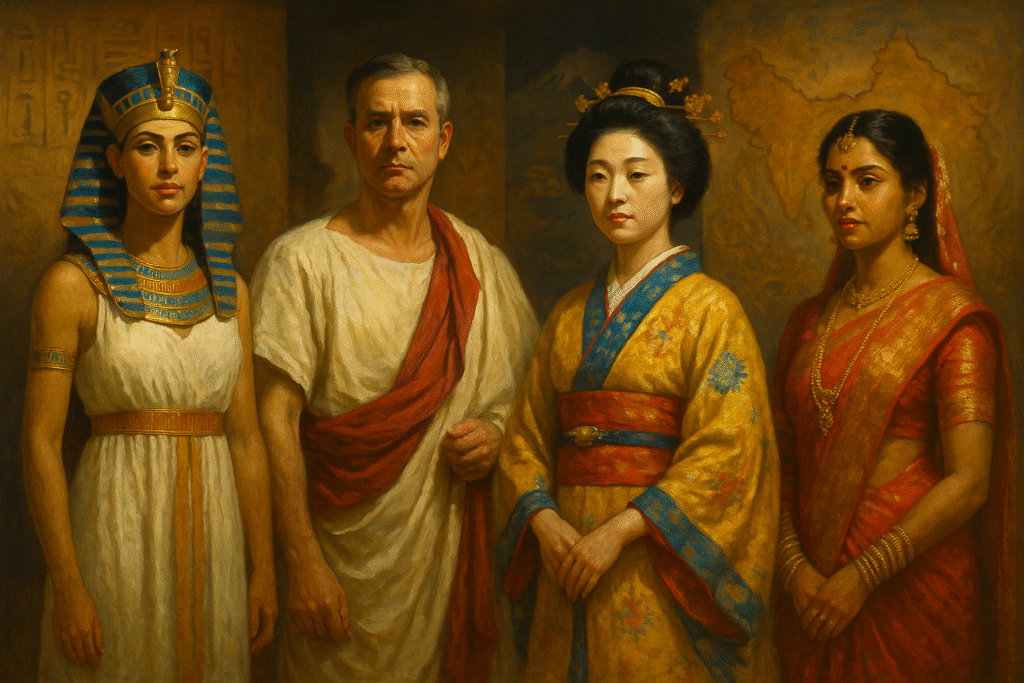Clothing has always been a powerful tool, mirroring the culture, identity, and influence of empires. By examining historical trends, we see how attire has shaped societies and become woven into the very fabric of nations. But how did clothing become a pivotal force in empire-building?
Unveiling Clothing History: The Evolution of Attire
The history of clothing is a reflection of artistry and necessity, illustrating societal shifts from ancient to modern times. Fabrics like the ancient Egyptians’ linen and Chinese dynasties’ silk have been pivotal in cultural expression. But how exactly did clothing evolve to symbolize power and identity?
1. Ancient Clothing: Linen in Egypt symbolized purity and status.
2. Medieval Textiles: European garments distinguished social and economic status.
3. Silk Road Influence: Silk became an emblem of luxury across continents.
4. Industrial Era: Mass production introduced new fabrics and democratized fashion.
5. Modern Movements: Sustainable materials challenge traditional norms.
Clothing evolution mirrors societal growth and cultural exchange. Fashion served not just as personal identity but as a statement of power across different regions.
The Impact of Clothing on Society: Social Hierarchies and Change
Clothing has dictated social hierarchies, with fashion often reflecting and reinforcing societal structures. During the French Revolution, attire clearly indicated social standing. But how did clothing influence changes within social classes?
* Indicators of Class: Clothing styles differentiated nobility from commoners.
* Fashion as Protest: Revolutionary dress styles symbolized political standpoints.
* Gender Roles: Attire historically reinforced gender expectations.
Fashion and Empires: The Symbiotic Relationship
Fashion and empires have influenced each other significantly. Empires like Rome used clothing—such as the toga—to signify citizenship and order. How did fashion and political power intersect?
1. Symbolism in Empire: Togas in Rome denoted political status.
2. Cultural Integration: Fashion facilitated the integration of conquered regions.
3. Economic Influence: Textile production underpinned empire economies.
4. Authority and Dress: Rulers set fashion trends to consolidate power.
Authoritative Source: University of Historical Research emphasizes how empires utilized fashion to convey strength and integrate diverse cultures (University of Historical Research, 2022).
Clothing in History: Defining Moments and Their Legacies
Throughout history, clothing has not only marked but shaped pivotal cultural identities, such as the sari in India and kimono in Japan. What are some defining fashion moments in world history?
1. Indian Sari: A timeless symbol of tradition and womanhood.
2. Japanese Kimono: Reflects societal roles and cultural stability.
3. Victorian Gowns: Indicative of social reform and industrial prosperity.
4. 1920s Flapper Dress: Signaled liberation and fashion revolution.
Data Insight: According to the Global Fashion Index, cultural garments define over 45% of a region’s initial international recognition (Global Fashion Index, 2023).
Sustainable Fashion History: A New Narrative
Sustainable fashion history marks society’s ecological shift, emphasizing responsible manufacturing and consumption. How have clothing choices adapted towards sustainability?
* Early Initiatives: Use of natural dyes and materials minimizing waste.
* Modern Movements: Designers promote circular fashion and ethical sourcing.
* Future Trends: Advances in technology propel sustainable innovation.
Environment Report: According to the Environmental Journal, over 60% of consumers now consider sustainability before purchase (Environmental Journal, 2022).
Cultural Heritage Clothing: Stories Woven in Fabric
Cultural heritage clothing tells tales of adversity and triumph, linking generations and celebrating identities. How do these textiles narrate history?
* Traditional Textiles: Handwoven garments preserve ancient techniques.
* Symbols of Resilience: Indigenous attire conveys cultural endurance.
* Collective Memory: Clothing as a vessel for historical stories.
The Textiles Institute highlights how preserving traditional fabrics strengthens cultural identity and regional unity.
Political Influence: Clothing as Silent Protest
Clothing has often played a role in political movements as silent forms of protest and expression. How significant was this influence in social change?
1. Suffragette White: Used symbolically for purity and women’s rights.
2. Black Berets: Embodied by the Black Panthers to signify resistance.
3. Rainbow Symbols: LGBTQ+ rights movements embraced expressive attire.
Clothing is indistinguishable from political discourse in its power to convey silent, yet compelling, messages.
Garments and Historical Change: A Timeline
* Ancient Times: Togas denote Roman citizenship.
* Middle Ages: Sumptuary laws enforce class dress codes.
* Renaissance: Tailoring innovations signify rebirth and status.
* Modern Era: Coco Chanel’s designs revolutionize women’s fashion.
* Contemporary Fashion: Fast fashion raises ethical and ecological questions.
Conclusion: How Clothing Narratives Shape Our World
Clothing has acted as a catalyst for societal transformation and cultural identity throughout history. As we navigate the future, understanding this history is crucial to making informed choices that honor legacy and promote sustainable practices. Whether it’s leveraging fashion to influence, protest, or unite, our attire tells ongoing stories that continually shape our world.


